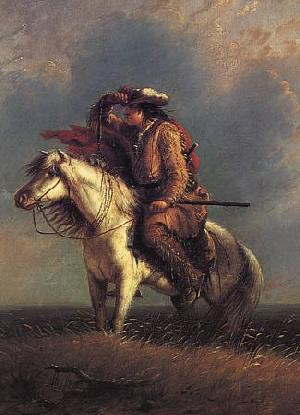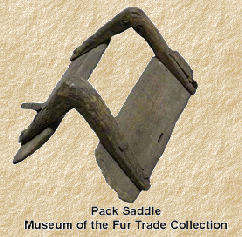Subject Guide

Mountain West
Malachite’s Big Hole
Horses:
Early efforts to exploit the fur resources of the Rocky Mountains attempted to utilize
the rivers for transportation as much as possible. In spite of this, early trappers
and explorers still found it necessary to acquire horses from the Indians. Lewis
& Clark relied on the Shoshone Indians to provide horses to cross the Rocky  Mountains
to the Columbia River basin. Then in 1811, the Overland Astorians found horses necessary
when they were forced to abandon the river route much sooner than they had anticipated
to avoid hostile Indians (See Ramsay Crooks). The year 1823 would see the horse
become the primary means of transportation for the Mountain Men. It was in this
year that Ashley and Henry would have their disastrous encounter with the Arikaree
Indians as they attempted to move a fur brigade upriver to the Upper Missouri River
country. After losing fifteen men killed and nine wounded, Ashley decided to avoid
the river entirely. He would trade for horses from friendly Indians, and would send
his men and pack supplies on horseback.
Mountains
to the Columbia River basin. Then in 1811, the Overland Astorians found horses necessary
when they were forced to abandon the river route much sooner than they had anticipated
to avoid hostile Indians (See Ramsay Crooks). The year 1823 would see the horse
become the primary means of transportation for the Mountain Men. It was in this
year that Ashley and Henry would have their disastrous encounter with the Arikaree
Indians as they attempted to move a fur brigade upriver to the Upper Missouri River
country. After losing fifteen men killed and nine wounded, Ashley decided to avoid
the river entirely. He would trade for horses from friendly Indians, and would send
his men and pack supplies on horseback.
Trappers and traders now entered the Great Plains and Rocky Mountain region on the
backs of horses and mules. No longer were they tied to the great rivers, and exploration
and exploitation exploded across the semi-arid regions of the West. However, unlike
the canoe and keelboat, this form of transportation requires food, water, and rest
for the animals. During the spring through fall, grass was widely available for pasturage,
except in the desert Great Basin. In the winter when fodder might be buried beneath
feet of snow, the bark of "Sweet" cottonwood would be stripped from the trunks and
used as feed. Rufus Sage writes: "horses and mules...thrive upon it in a remarkable
manner, and even in summer months they prefer it to grass. The bark of red elm is
also used..."
exploration
and exploitation exploded across the semi-arid regions of the West. However, unlike
the canoe and keelboat, this form of transportation requires food, water, and rest
for the animals. During the spring through fall, grass was widely available for pasturage,
except in the desert Great Basin. In the winter when fodder might be buried beneath
feet of snow, the bark of "Sweet" cottonwood would be stripped from the trunks and
used as feed. Rufus Sage writes: "horses and mules...thrive upon it in a remarkable
manner, and even in summer months they prefer it to grass. The bark of red elm is
also used..."
Both horses and mules were favored animals, however, they were treated as expendable tools, not as friends or pets. The reports and journals of the Mountain Men are filled with stories of horses dying as a result of hard use, lack of food or water, falling off cliffs, freezing, drowning or being killed for the food they could provide during starving times. “Ya don’t name somethin’ ya might have ta eat” sums up the relation between the mountain man and his horse. In fact though many Mountain Men did name their horses and mules.
The horse in the 1830's was not as large as their modern descendents. Pictures drawn
by contemporary artists indicate that these horses probably averaged about  14 hands
high, and probably weighed about 700 pounds. Of coarse their riders were also much
smaller. Men in the 1830's averaged about 5"8" and weighed about 140 pounds. The
picture at left, titled “The Lost Greenhorn” is by Alfred Jacob Miller done in 1837
when he accompanied William Drummond Stewart, a wealthy Scotsman, to the mountains.
14 hands
high, and probably weighed about 700 pounds. Of coarse their riders were also much
smaller. Men in the 1830's averaged about 5"8" and weighed about 140 pounds. The
picture at left, titled “The Lost Greenhorn” is by Alfred Jacob Miller done in 1837
when he accompanied William Drummond Stewart, a wealthy Scotsman, to the mountains.
Indians, both hostile and friendly, considered horses extremely desirable, and would steal any horses or mules not closely guarded, no matter who they belonged to, foe or friend. Horse stealing amongst Indians was done as much for the challenge and sport as it was for need. Many Indian tribes did not have a distinct word for horses, commonly referred to horses as "Medicine Dogs" or “Big Dogs.”
While traveling in a brigade, each man would usually be responsible for his own horse,
plus two or three pack animals. A horse could carry two one-hundred pound packs,
one pack on each side of the horse strapped to the pack saddle. Each day would start
with a small breakfast if any and coffee. Around noon, the brigade would halt for
about two hours mostly to allow the horses to feed, water and rest. The march would
resume until late afternoon, or early evening, or until a campsite with adequate
water, graze and firewood was found. In setting up camp, all of the packs, saddles,
tents and other gear were formed into a rough square. Horses were hobbled or tethered
to graze until dark, then all the animals were brought inside the perimeter formed
by the gear and picketed for the night. The men were divided into "messes" of eight
to ten individuals for cooking and to help with camp chores. At night, each member
of a mess would take his turn for a period of guard duty (for first hand descriptions
of guard duty). When not hunting, or otherwise distracted, a brigade would often
travel about 25-30 miles in a day. Distance traveled was dependent on the nature
of the country. If the horses had to pick their way through downed timber, brush,
or steep rocky ground, the distance traveled could be as little as a few miles.
march would
resume until late afternoon, or early evening, or until a campsite with adequate
water, graze and firewood was found. In setting up camp, all of the packs, saddles,
tents and other gear were formed into a rough square. Horses were hobbled or tethered
to graze until dark, then all the animals were brought inside the perimeter formed
by the gear and picketed for the night. The men were divided into "messes" of eight
to ten individuals for cooking and to help with camp chores. At night, each member
of a mess would take his turn for a period of guard duty (for first hand descriptions
of guard duty). When not hunting, or otherwise distracted, a brigade would often
travel about 25-30 miles in a day. Distance traveled was dependent on the nature
of the country. If the horses had to pick their way through downed timber, brush,
or steep rocky ground, the distance traveled could be as little as a few miles.
Horses were not a complete panacea for mountain transportation. Accidents involving horses were numerous, with resulting death or injury to the animal, it's rider, or packs common. Accidents were in fact so common that Harrison Rogers in one notable entry in his journal on July 2, 1829 "no accident has happened in regard to horses today."
Horses became so indispensable to the Mountain Man's way of life and business, that premium prices would be paid for these animals in the mountains. Fur trappers might pay a hundred dollars or more (or its equivalent in trade goods.) in the mountains for a horse, and as much as two hundred dollars depending on desperation. In the settlements in 1830's horses could generally be purchased for $30-$40 a head. At this time the ranches in Mexico had huge herds of horses, with correspondingly low prices. In Santa Fe horses could be bought for $6-$10, and in Spanish or Mexican California at similar prices. Unbroke horses could be purchased for as little as $1-$2 in California. In spite of the low cost of Mexican horses, many Indians and more than a few Mountain Men would travel to Mexico or California for the sole purpose of stealing horses. However, in attempting to elude the unhappy legitimate owners, often well over half of the stolen herds would be lost or die. The Mexicans were scrupulous about branding their horses and mules. On sale of an animal, the horse or mule was "unbranded" and then immediately rebranded. A horse or mule could only hope that it wasn't sold often.
Follow this link for an article about Saddles.
Follow this link for an article about
Horseshoes.
Back to the Top
Back to Transportation
Which Was Better-Horses, Mules or Oxen
Draft Animals on the Santa Fe Trail
The horse was used almost exclusively on the Santa Fe Trail but was rapidly replaced by mules when those animals became available. In 1829 an Army escort for the traders used oxen as far as the border with Mexico; Charles Bent borrowed several yoke and took them as far as Santa Fe as an experiment. Thereafter oxen and mules were both untilized as draft animals.
Mules were able to travel faster than oxen and generally maintained their strength better. Oxen could pull a heavier load than an equivalent number of mules, especially under muddy or sandy conditions. Oxen did have feet that were more tender than mules, especially if improperly shoed. Mules were far more expensive than oxen; a team of six mules might cost $600, whereas four yoke of oxen about $200. Mules were often able to make the return trip from Santa Fe, whereas oxen were generally not.
On the trail oxen were much less likely to take fright and stampede than mules, and if oxen did stampede were more easily recovered. Indians greatly preferred stealing mules, generally ignoring oxen, though they would on occasion shoot arrows into oxen. And in times when food was scarce, oxen were much better as an emergency food source than mules.
So what would you take on the Santa Fe Trail to pull your wagon?